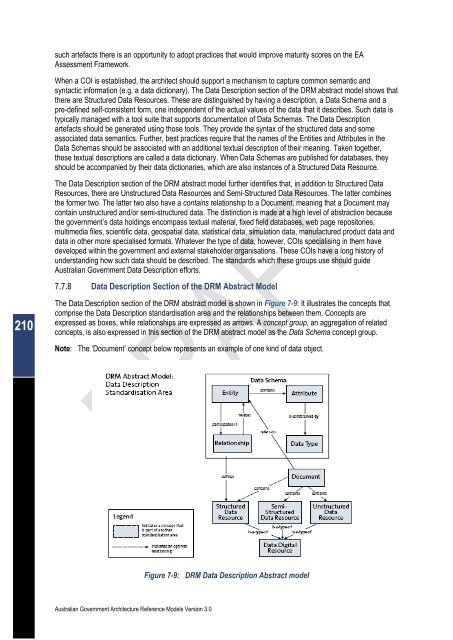Australian Government Architecture Reference Models Version 3.0
Australian Government Architecture Reference Models Version 3.0
Australian Government Architecture Reference Models Version 3.0
Create successful ePaper yourself
Turn your PDF publications into a flip-book with our unique Google optimized e-Paper software.
210<br />
such artefacts there is an opportunity to adopt practices that would improve maturity scores on the EA<br />
Assessment Framework.<br />
When a COI is established, the architect should support a mechanism to capture common semantic and<br />
syntactic information (e.g. a data dictionary). The Data Description section of the DRM abstract model shows that<br />
there are Structured Data Resources. These are distinguished by having a description, a Data Schema and a<br />
pre-defined self-consistent form, one independent of the actual values of the data that it describes. Such data is<br />
typically managed with a tool suite that supports documentation of Data Schemas. The Data Description<br />
artefacts should be generated using those tools. They provide the syntax of the structured data and some<br />
associated data semantics. Further, best practices require that the names of the Entities and Attributes in the<br />
Data Schemas should be associated with an additional textual description of their meaning. Taken together,<br />
these textual descriptions are called a data dictionary. When Data Schemas are published for databases, they<br />
should be accompanied by their data dictionaries, which are also instances of a Structured Data Resource.<br />
The Data Description section of the DRM abstract model further identifies that, in addition to Structured Data<br />
Resources, there are Unstructured Data Resources and Semi-Structured Data Resources. The latter combines<br />
the former two. The latter two also have a contains relationship to a Document, meaning that a Document may<br />
contain unstructured and/or semi-structured data. The distinction is made at a high level of abstraction because<br />
the government’s data holdings encompass textual material, fixed field databases, web page repositories,<br />
multimedia files, scientific data, geospatial data, statistical data, simulation data, manufactured product data and<br />
data in other more specialised formats. Whatever the type of data, however, COIs specialising in them have<br />
developed within the government and external stakeholder organisations. These COIs have a long history of<br />
understanding how such data should be described. The standards which these groups use should guide<br />
<strong>Australian</strong> <strong>Government</strong> Data Description efforts.<br />
7.7.8 Data Description Section of the DRM Abstract Model<br />
The Data Description section of the DRM abstract model is shown in Figure 7-9: It illustrates the concepts that<br />
comprise the Data Description standardisation area and the relationships between them. Concepts are<br />
expressed as boxes, while relationships are expressed as arrows. A concept group, an aggregation of related<br />
concepts, is also expressed in this section of the DRM abstract model as the Data Schema concept group.<br />
Note: The ‘Document’ concept below represents an example of one kind of data object.<br />
<strong>Australian</strong> <strong>Government</strong> <strong>Architecture</strong> <strong>Reference</strong> <strong>Models</strong> <strong>Version</strong> <strong>3.0</strong><br />
Figure 7-9: DRM Data Description Abstract model

















